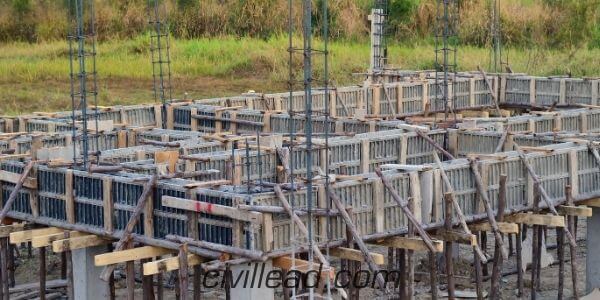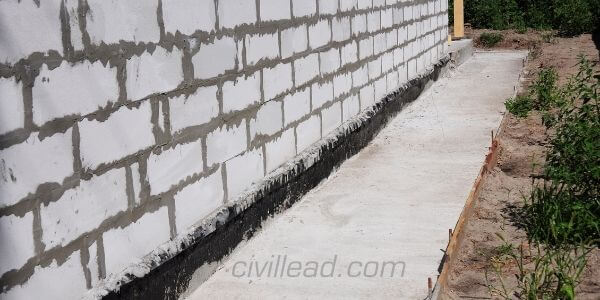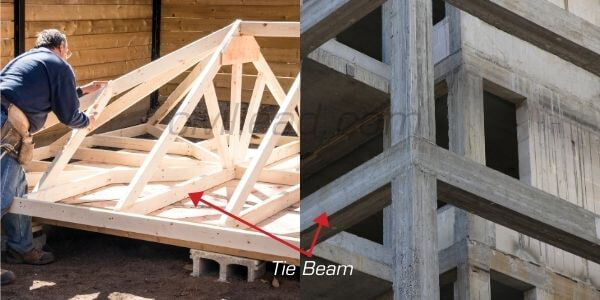Table of Contents
What is Plinth Beam?
A Beam that is cast at or above the ground level refers to the plinth beam. It is a part of the superstructure lying between floor level and ground level.
The plinth helps to transfer the live load and the structure’s dead load to the foundation. It also provides safety to the building against the penetration of moisture and gives an excellent architectural appearance.
Purpose of the Plinth Beam in a Structure
It is an essential member of a frame structure to complete the following objects listed below.
- One of the main features of the plinth is that it evenly distributes the structure’s load to the foundation and prevents it from the differential settlement.
- It helps stop the entry of moisture in the building, thus protecting the wall from dampness.
- It assists to tie all the columns, reducing the effective length of the column, thus avoiding the chance of buckling and keeping the beam and column connected.
- It works like a retaining wall and holds the backfill materials.
- It provides a bearing surface for the masonry constructed over it.
- It helps to reduce the probability of cracks in masonry built over it.
- Furthermore, it also enhances the building’s aesthetic look.
- It prevents crack propagation from the foundation to the above wall,
Also, Read – What is M Sand? – 20 Properties, Advantages & Disadvantages
Application of Plinth Beam
- It is necessary to construct a plinth beam in an earthquake-prone area.
- Another application of this type of beam is its construction above the natural ground level.
Preferred strength of concrete for the construction of plinth Beam
- The strength of concrete used to cast the plinth beam should not be less than 20 MPA.
- If manual mixing is adopted, it is necessary to add 20% additional cement to the mixture.
Plinth Beam Minimum Dimension
The minimum required depth for the plinth beam is 20 cm, and its width should equal the foundation’s final course.
Formwork for plinth Beam

Formwork used for constructing the plinth beam should be installed appropriately and adequately secured before placing the concrete. For preventing steel bars from corrosion, concrete requires to be compacted adequately.
The steel bars used for plinth Beam
It is preferred to provide two bars of a minimum of 12 mm diameter at the bottom of the beam. Similarly, two bars of minimum 10 mm diameter at the top of the beam.
Stirrups of a minimum 6 mm diameter bar at a spacing of 150 mm should be provided. Concrete cover of 25 mm should protect steel bars.
What is Plinth Protection?
The surrounding area of the building generally refers to plinth protection. Plinth protection is usually provided by placing a plain cement concrete layer of thickness about 75 to 100 mm along building edges.
Plinth protection is provided to stop the infiltration of water in the soil reaches the plinth wall and floor level by capillary action resulting in dampness. It acts as a barrier and blocks water’s direct entry into the ground near the plinth wall.

Suppose water percolate into the ground, and the foundation experiences the settlement. In that case, Plinth protection is necessary to prevent the continuation or spread of cracks from the foundation into the above wall in such a condition.
However, Plinth protection can also be done by providing gravel, paver blocks, and by surrounding the lawn.
Important Point While providing Plinth Protection
- Cushioning sand should be provided for PCC of plinth Protection
- The width of plinth protection (PPC) should not be less than one meter.
- Slop must be provided in the PCC of plinth protection.
- The thickness of PCC for plinth protection should not be less than 75 mm.
AAC Blocks – Properties, Advantages, Disadvantages and Laying Process
What is Tie Beam?

The beam that connects two or more than two columns/rafters in a roof/roof truss at any height of the structure refers to a tie beam.
Tie beams are essentially provided in the roof trusses and at the plinth level. It does not convey any load and acts only as a length breaker for columns where the slab height is unusually high.
A plinth beam is also a tie beam, but it is provided at plinth level that’s why it is called a plinth beam.
Generally, A tie beam should provide when the column’s height rises from the range of 4 to 5 meters. But, this is not the exact figure to be always followed. Structural Engineers may change it as per the structure’s need.
Also, Read – Difference Between Beam and Lintel
Functions of Tie Beams
- The tie beam is provided to convey compression axially.
- It decreases the column’s effective length.
- It defends the column from buckling.
- It helps to decrease the column’s slenderness ratio.
Difference Between Plinth beam and Tie Beam
There are no significant differences between these two beams. The one thing that differentiates these two beams is their location.
We provide a plinth beam at the plinth level; therefore, it refers to the plinth beam.
While we can provide a tie beam at any elevation, we generally provide a tie beam above the floor level. The lintel beam is also a tie beam.
Both beams follow the same construction procedure. Both beams are designed as per the structure’s requirement.
But when there is a significant difference between natural ground level and road level, we also use a tie beam below the plinth level.
I hope now you gain significant knowledge about the plinth beam, plinth protection, Tie beam, and differences between these two beams. Please share this information with your friends.
Thanks!
Also, Read
Difference Between Singly and Doubly Reinforced Beam
What is an Estimate?-Importance, Estimate of Building in Excel
What is BOQ? – Purpose, Importance, Advantages and Disadvantages
10 – Best Cement Companies in India.
Difference Between OPC and PPC Cement.
What is Development Length? – Complete Guide
What is Lap Length? How to calculate it? – Complete Guide
thank you sir for this info very nice work
Thanks for your valuable feedback.